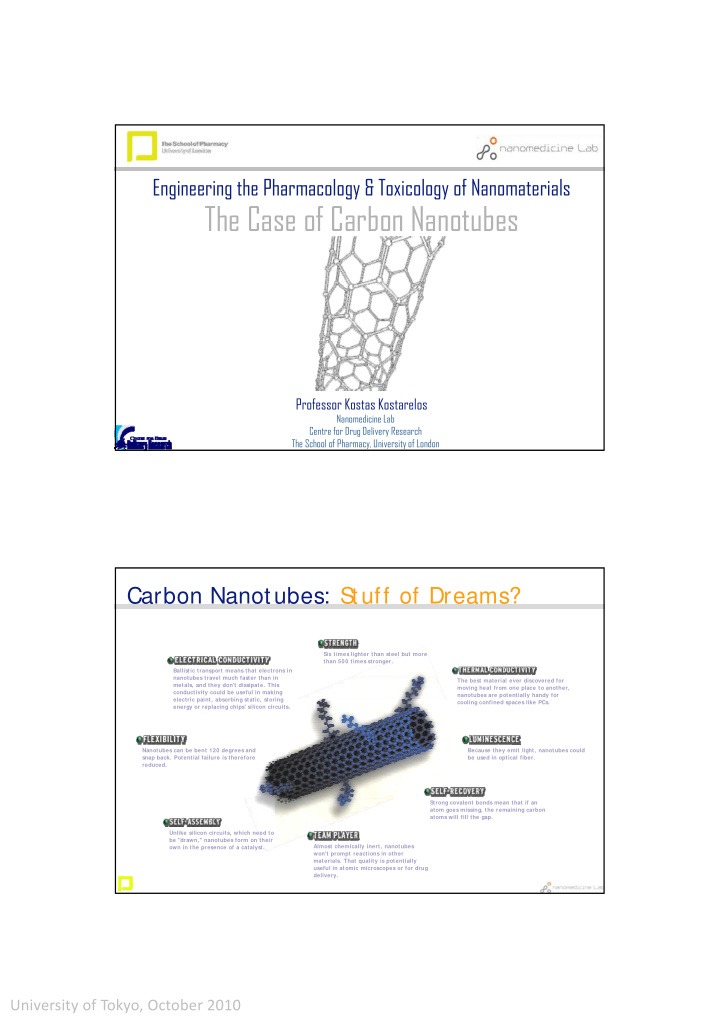



Engineering the Pharmacology & Toxicology of Nanomaterials The Case of Carbon Nanotubes Professor Kostas Kostarelos Nanomedicine Lab Centre for Drug Delivery Research The School of Pharmacy, University of London Carbon Nanotubes: S tuff of Dreams? Six times lighter than steel but more than 500 times stronger. Ballistic transport means that electrons in nanotubes travel much faster than in t b t l h f t th i The best material ever discovered for metals, and they don't dissipate. This moving heat from one place to another, conductivity could be useful in making nanotubes are potentially handy for electric paint, absorbing static, storing cooling confined spaces like PCs. energy or replacing chips' silicon circuits. Nanotubes can be bent 120 degrees and Because they emit light, nanotubes could snap back. Potential failure is therefore be used in optical fiber. reduced. Strong covalent bonds mean that if an atom goes missing, the remaining carbon atoms will fill the gap. Unlike silicon circuits, which need to be "drawn," nanotubes form on their Almost chemically inert, nanotubes own in the presence of a catalyst. won't prompt reactions in other materials. That quality is potentially useful in atomic microscopes or for drug delivery. University of Tokyo, October 2010
Carbon Nanotubes: S tuff from Hell? Carbon Nanotube Definition from Amorphus Carbon to Novel Nanomaterial Amorphous carbon Graphite Amorphous carbon Graphite Diamond Diamond Fullerene Carbon nanotube University of Tokyo, October 2010
Carbon Nanotubes in Biology & Medicine • Only a few types of CNT used in biomedical applications biomedical applications • Pristine material without surface modification should be avoided • The fundamental needs to be achieved are: ‐ aqueous and biological fluid dispersibility ‐ nanotube individualisation Kostarelos, Bianco, Prato. Nature Nanotechnology, 2009 Universality in f ‐ CNT intracellular uptake? Kostarelos et al., Nature Nanotechnology, 2007, 2, 108 ‐ 1484 University of Tokyo, October 2010
The ‘Nanoneedle’ Hypothesis CELL MEDIUM CYTOPLASM Pantarotto et al. Angewandte Chemie International Edition, 2004 Lacerda et al. Journal of Materials Chemistry, 2008 Lacerda et al. NanoToday, 2008 Carbon Nanotubes for Biomedicine Why is all this interesting? Why is all this interesting? University of Tokyo, October 2010
CNT ‐ mediated siRNA delivery nuclei siRNA DIC siRNA ‐ ATTO 655 Liposome:siRNA HeLa 3 hrs transfection f ‐ CNT:siRNA 48 hr Evaluate Intracellular Fluorescence (siRNA) Al ‐ Jamal, K. et al., FASEB J, 2010 Carbon Nanotube Pharmacology Pharmacology University of Tokyo, October 2010
CNT Pharmacology What’s ‘ Good’ and what’s ‘ Bad’ • ‘ Good’ is long blood circulation & high degree of excretion • ‘ Bad’ is tissue accumulation ‘ d’ l that may lead to side effects CNT Pharmacology Radiolabelling Administration Intravenous (tail vein) A[ 111 In] A[ 111 I ] MWNT DTP MWNT-DTP CO 2 H CO 2 H O (50 µg / 1.5-10 MBq) O O NH O N N CO 2 H O N N N N H HO 2 C O N Mice / Rats Mice / Rats N N O O = O [ 111 In]DTPA O In O O O O 5min, 30 min, 24 hr Evaluate S PECT/ CT imaging University of Tokyo, October 2010
CNT Pharmacology Tissue Distribution (Dynamic 1-D S PECT) Head 100 Standard Standard Heart oactivity Level (a.u.) O O NH N Kidneys Radio Bladder 0 Tail Real time: 5 min Lacerda et al, Advanced Materials, 2008 CNT Pharmacology Urinary Excretion (TEM analysis of urine) SWNT-[DTPA] (scale 500 nm) MWNT-[DTPA] (scale 100 nm) Singh et al, PNAS, 2006 University of Tokyo, October 2010
CNT Pharmacology Urinary Excretion Mechanism (kidney TEM) Bundled MWNT found in the glomerular capillaries 500 nm CNT Pharmacology Urinary Excretion Mechanism (kidney TEM) Individual CNT Lumen of glomerular capillary Lumen of glomerular capillary EC P RBC E E E E BM Urinary space P 0.5 μ m Urinary space 0.2 μ m 5 min 30 min Lacerda et al, SMALL, 2008 University of Tokyo, October 2010
Carbon Nanotube Toxicology Toxicology CNT Toxicology Peritoneal Model CNT Toxicity • Surfactant ‐ based dispersions of pristine, long (>20µm) CNT • • Compared to asbestos fibers d b fib • Reported asbestos ‐ like reactivity that can lead to carcinogenicity Kostarelos, Nature Biotechnology, 2008 University of Tokyo, October 2010
CNT Pharmacology & Toxicology Conclusions • CNT interact with biological matter leading to biological activity • CNT structural and surface characteristics determine biological profiles in vitro and in vivo • Chemical functionalisation with small hydrophilic groups that can lead to individualised CNT can cross the glomerular filter and be excreted in urine • Processes that can lead to shorter that 5µm h l d h h CNT can completely alleviate the asbestos ‐ like reactivity Kostarelos, Nature Biotechnology, 2008 • CNT Structure ‐ Biological Function studies are the only way forward Carbon Nanotubes in Medicine into perspective… into perspective University of Tokyo, October 2010
Carbon Nanotubes in Medicine (preclinical animal models only) • Oncology is the prime indication when CNT are used in medicine when CNT are used in medicine • Proof ‐ of ‐ principle systemic targeting of CNT (both coated and functionalised) using peptides (RGD) and antibodies shown • Only two studies reported y p therapeutic efficacy to prolong survival of tumor ‐ bearing animals • Disease models in immunology and neurology at the proof ‐ of ‐ principle Kostarelos et al. Nature Nanotechnology, 2009 The Funding NINIVE University of Tokyo, October 2010
Recommend
More recommend